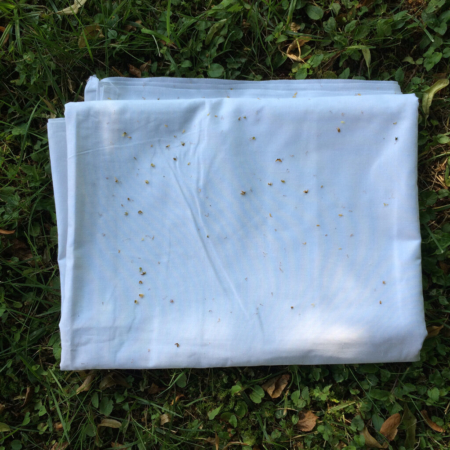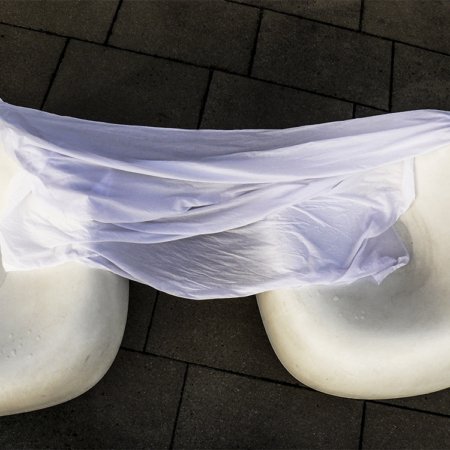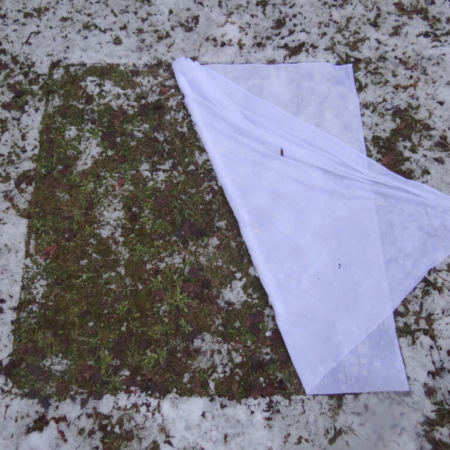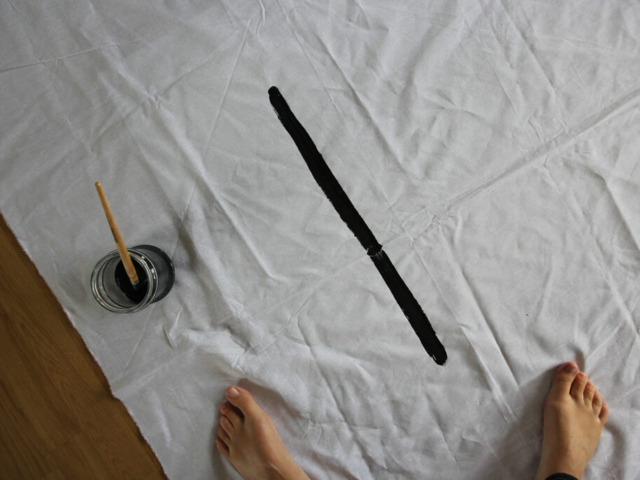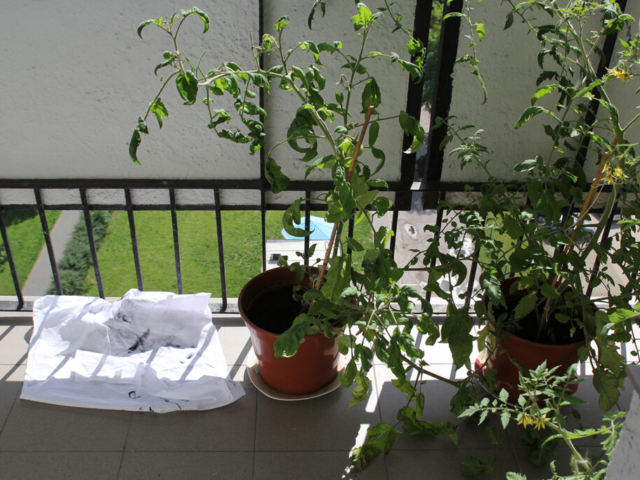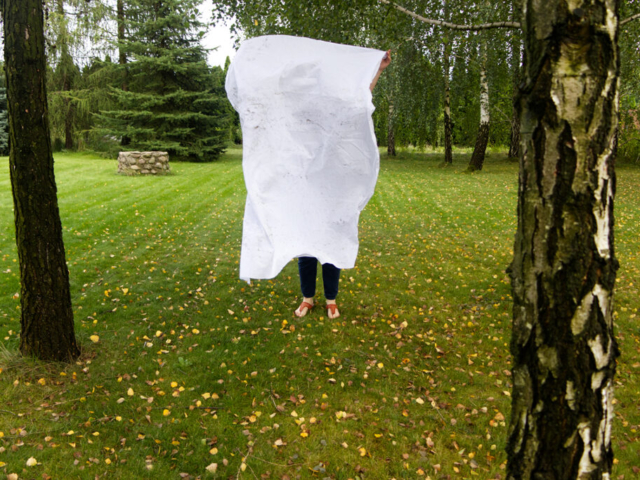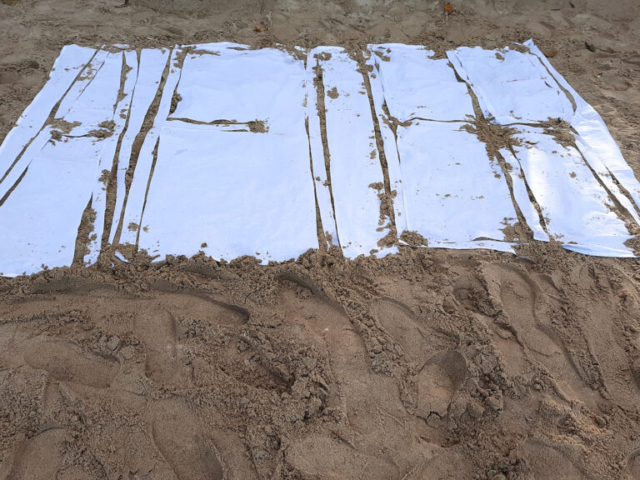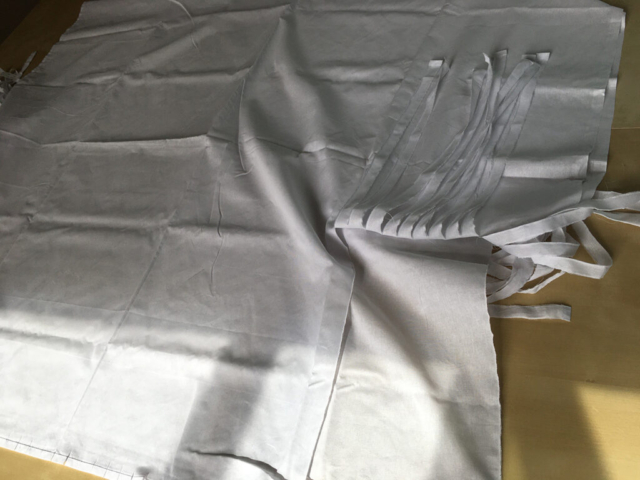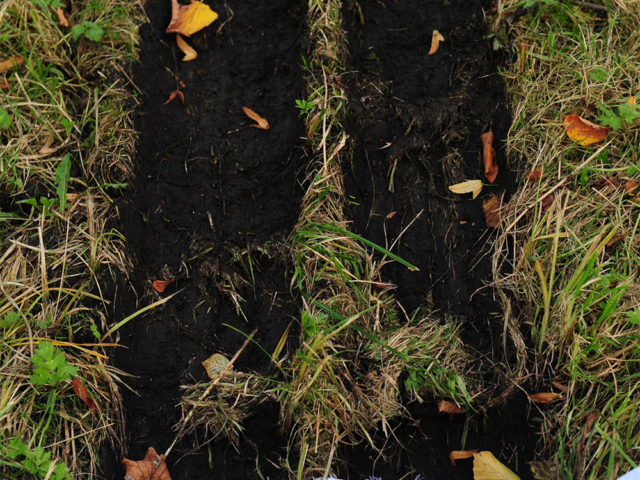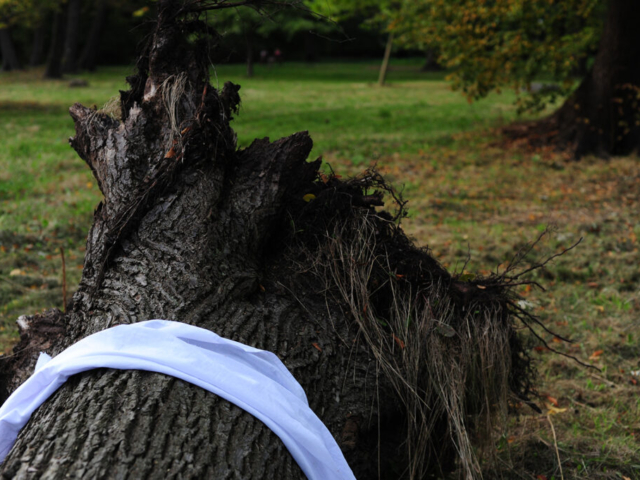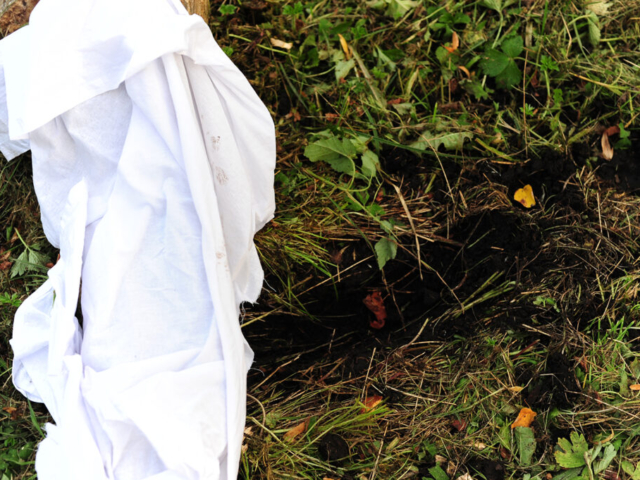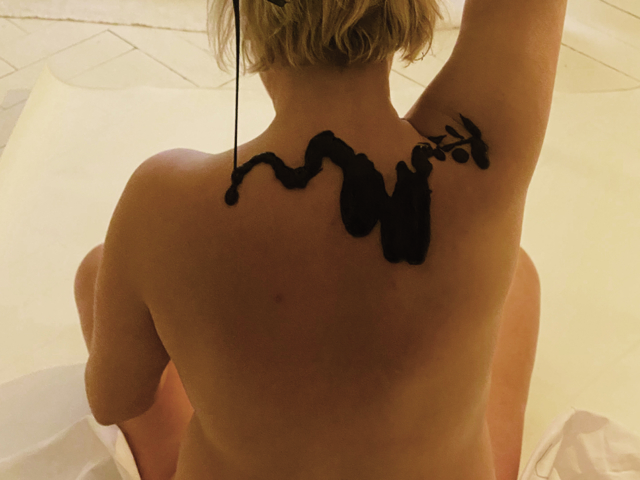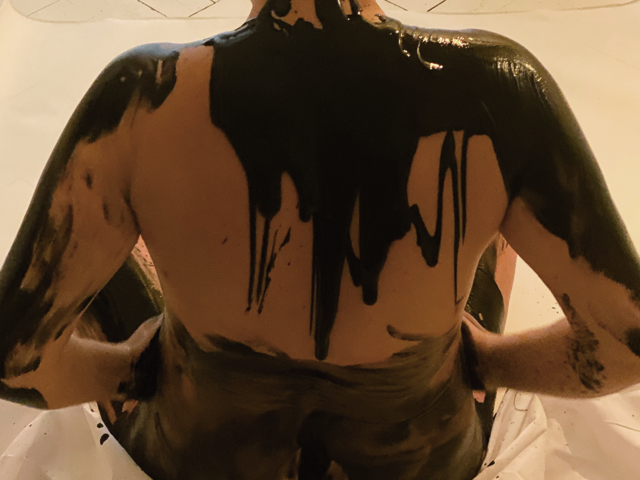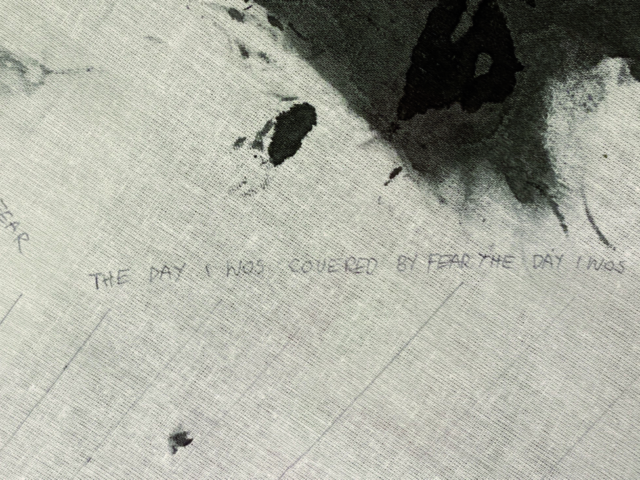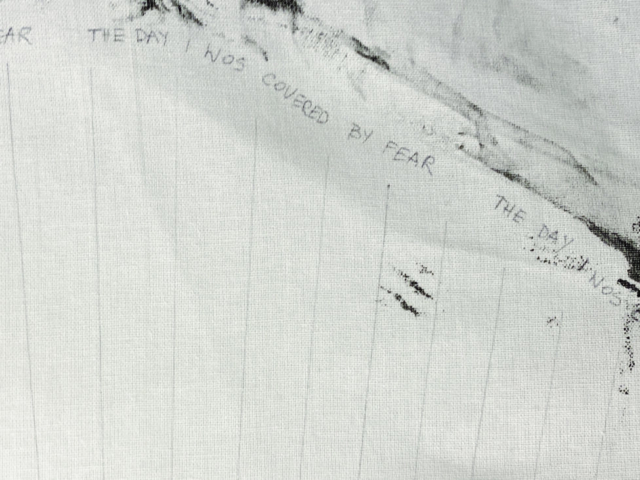Ein Tuch wird an Künstlerinnen von Endmoräne und der Frakcja-Gruppe verschickt. Es wird an ein Gebäude gehängt, an einen Baum, auf eine Wiese gelegt, gefaltet. Die Spuren des Transportes, die Spuren des Ortes, der Zeit bleiben. Dann wird das Tuch wieder auf den Weg gebracht, zurückgeschickt. Sie werden aufeinandergestapelt, gehen auf Tuchfühlung. Der Abstand schwindet. Die Spuren bleiben. Die Aktionen wurden dokumentiert. 2020
„Tuch in der Panke“, Berlin, Idee: Claudia Busching, Video: Angela Lubic
„Marder auf Tuchfühlung“, Lambsheim, Idee: Lutz Bernd, Angela Lubic
„Die Fahne“, Berlin Charlottenburg, Rotraud von der Heide
„Weg Zeit“, Berlin, Elke Postler
Marta Ostajewska „die überreste“, 2020 (balkon/Łódź)
resztki polnische Version →
i can’t breathe.
nagle niebo stanęło. zamilkło. samoloty ułożone jak małe zabawki na płycie lotniska, cicho odbijały słońce na zmatowiałych skrzydłach.
zamknięto wszystko. lasy, chodniki, niebo, oddech.
2020 stał się rokiem ciszy, przerywanej głośnymi wybuchami krzyku
i can’t breathe.
balkon stał się całym światem.
poszczególne dni odliczał dystans doniczek, powoli rozrastających się pomidorów i cukini.
i can’t breathe.
wstrzymany na chwilę oddech – z powodu braku, czy może nadmiaru?
świat najpierw stanął, a później gwałtownie przyspieszył.
1,5m metra dystansu. kolejki w sklepach. maseczki. przyłbice. rękawiczki. godziny dla seniorów.
czas jak plastelina, reguły zmieniające się w mgnieniu oka.
odcinasz odległości w powietrzu, od człowieka do doniczki. od doniczki do nieba.
białe, niemieckie, rozerwane na kawałki prześcieradło zbiera z powietrza drobinki polskiego kurzu.
czy tak teraz będziemy podróżować?
i can’t breathe.
kawałek materiału. niepotrzebne nikomu resztki. nasze dłonie zwijają je w kulkę i wyrzucają za balkon. za – granice naszego świata.
śmieci płowieją w słońcu.
i can’t breathe.
Działanie: prześcieradło porwane na dwa kawałki (1,5 metra zaznaczające dystans społeczny w pandemii i reszta) wisi na balkonie zbierając ślady. Zapisane na nim słowa płowieją w powietrzu. W powietrzu, w którym za chwilę nie da się oddychać od smogu. Teraz nie da się oddychać ze strachu (Black Lives Matter, Białoruś, Bejrut, nagonka na LGBTQ, COVID…).
show less
i can’t breathe.
plötzlich blieb der himmel stehen. verstummte. die flugzeuge, die wie kleine spielzeuge auf dem asphalt gestapelt waren, reflektierten sanft die sonne auf ihren angelaufenen flügeln. alles war geschlossen. alles wurde geschlossen. wälder, gehsteige, himmel, atem.
2020 wurde zum jahr der stille, unterbrochen durch laute ausbrüche des schreiens.
i can’t breathe.
der balkon wurde zur ganzen welt.
die einzelnen tage wurden durch die strecke zwischen blumentöpfen, langsam wachsenden tomaten und zucchini, gezählt.
i can’t breathe.
der atem angehalten für einen augenblick – aufgrund von mangel oder überfluss?
die welt ist zuerst stehengeblieben
weiterlesen →
1,5 meter distanz, schlangen in geschäften, masken, visier, hanschuhe, stunden für senioren.
zeit wie plastilin, regeln verändert in einem augenblick.
du schneidest die strecke in der luft ab, von einem menschen bis zu einem blumentopf, von einem blumentopf bis zum himmel.
ein weißes, deutsches, ausgerissenes bettlaken sammelt aus der luft polnische staubteile.
werden wir so reisen?
i can’t breathe.
ein stück von stoff, unnötige überreste, unsere hände rollen es zu einer kugel und werfen es über den balkon. jenseits die grenzen unserer welt.
müll verblasst in der sonne.
i can’t breathe.
Handeln: Bettlaken zerreissen in zwei Teile (1,5 Meter markiert die soziale Distanz in der Pandemie und den Rest), hängt auf dem Balkon und sammelt Spuren. Die auf ihm geschriebenen Worte werden in der Luft matt. In der Luft, die man bald wegen Smog nicht atmen kann. Jetzt kann man aus Angst nicht atmen (Black Lives Matter, Weißrussland, Beirut, Hetzjagd auf LGBTQ, COVID…).
weniger anzeigen
Roksana Kularska-Krol
First of all I treated the fabric with water. It was rain or garden water. It took me 2 weeks.
Later, I waited for the rain and reflected the traces of wet trees on the fabric.
For me it is some kind of shroud. The contact with trees is very important for me.
It gives me strength and hope in this pandemic situation. Only nature can save us!
Anka Lesniak weiterlesen → weniger anzeigen
This year I got to know that I had to undergo the surgery of my thyroid. The cause of it was a little, tiny lump, but malicious one and already determined to devour me slowly. So I got rid of it together with a part my body. This was the price… Although my thyroid was never much diligent, or maybe it was just too weak, I was a bit sorry for loosing it.
A few days after my surgery, the invitation to the project Abgefahren came. Together with it, I have received a beautiful cotton textile from Susanne. „Abgefahren“ means that something has gone, passed away, ended. What has been lost, when pandemic came? What will pass away with it? What has gone forever?
The trace that something was lost will last. The scar on my body will last until l live.
Susanne asked me to cut off a part of the textile to mark a required distance between people in the pandemic time.
I torn the textile while asking myself what was before and what will be after…
How to put together the world broken apart. Like a surgeon who cut my skin, removed a piece of me and then sewed everything neatly. The only trace of it is a thin reddish line on my neck.
Beside it I look the same. It seems that the surgery did not affect my mind and functions of my body.
I just take a higher dose of the medicine.
And I am fully depended on it now. How wonderful the artificial can replace the natural.
On the 22nd of October the so-called Constitutional Court, in fact completely subdued to the governing party in Poland, made almost all cases of abortion illegal, including those with severe and irreversible disability, or incurable and life-threatening disease of the fetus.
Abgefahren.
Women in the whole Poland took the streets.
We protest, we shout: This is war!
The doctor who consulted me after the surgery, told me that it was a good decision to remove the whole thyroid. He casually added that to keep a part of it would be safer only in a case of war and a lack of the medicine. Then, having still a little bit of my own hormone, I would survive.
No other doctor presented such a point of view before… maybe because this one was also a soldier…
I still have this piece of textile from Susanne that left after cutting off two meters of it.
The ideal size for a banner or flag.
I copied the remaked Solidarity logo and painted with red the message for Polish goverment on it.
This is war!
Beata Marcinkowska
I measured 1.5 meters from the fabric sent by Susanne. This is a social distance that is currently in force in Poland. I decided to use these 1.5 meters of fabric and leave traces on it, in the form of my action. I made something like a straitjacket out of it.
In Polish, a straitjacket is described in two words: a jacket and the term safety. This is literally a safety jacket.
From 1 meter of unused fabric, I made straitjacket ties. Thanks to this, in the straitjacket I could be closed, laced, tied, separated from reality. Social distancing is a kind of restriction, as is the straitjacket.
However, a tied straitjacket shortens the distance. Distance disappears when you are in a straitjacket.
I asked to tie me in a straitjacket (safety jacket) with a tree. I couldn’t touch anyone, but I could touch nature. It made me feel safe.
„O.T.“ Video, Beata Marcinkowska
Aurelia Mandziuk + Alicja Kujawska „obrus dystans“, 2020
2 meters of distance, 2.5 meters cloth of fabric.
It was a pity to tear off such a nicely finished piece of cloth sent by you – it’s a good cotton, with certificates saying that the plant was grown organically, and it’s has an eco-test as a fabric. It was easy to imagine the thousands of liters of water it had taken to produce it. It’s just as easy to imagine this material as a tablecloth. I like to embroider, so I suggested embroidery, but Aurelia – with whom we did it together because we live together – suggested hemstitching.
(Hemstitch, drawn work, Hohlsaum – a technique of openwork embroidery where threads are always threaded from the fabric in one direction.
Before cutting the threads, one should carefully
weiterlesen →
Aurelia took out the threads in the 2-meter spot, I pierced the hemstitch. On one of the edges there is also a piece „unfinished“ – in Poland the distance of 2.5 m was discussed and it was to embody this „discussion“.
Making hemstitch takes time, requires concentration, and pandemic doesn’t help in the focus department, but thanks to talking to my daughter and listening to the music she recommended, we finally managed to do four meters. As a result, it can be said that the hemstitch has become an embroidery connecting three generations.
The photos we took with the finished tablecloth show how far apart you would have to sit if you followed these recommendations also at home. The thought is quite scary though. How long will it take? How much will interpersonal relationships change? How will we connect with other human beings?
weniger anzeigen
„obrus dystans“, Aurelia Mandziuk + Alicja Kujawska
Izabela Maciejewska „Traces“, 2020
Ślady polnische Version →
Spędziłam popołudnie w parku wśród tych uśmierconych drzew. Odciętym kawałkiem materiału opatrywałam ich okaleczone członki. Zakrywałam na ziemi ślady po urządzeniach, którymi dokonano zniszczeń. Miękka ziemia zarejestrowała wszystko. Każdy odcisk.
Rzeczywistość wokół nas się zmienia. Tracimy grunt pod nogami, jak te drzewa, które z użyciem ciężkiego sprzętu poprzewracano z dnia na dzień i wyrwano ich korzenie z ziemi. Okaleczono. Obcięto gałęzie.
Reszta płótna leżała na trawie, gromadząc opadłe jesienne liście i ślady słońca do chwili, gdy widok kałuży błota w wyrwie po drzewie przywołał wspomnienie z dzieciństwa. Miałam 6 lat, kiedy na podwórku znalazłam śnieżnobiałe prześcieradła suszące się w słońcu na rozciągniętych sznurkach. Ogromną radość sprawiło mi pomalowanie ich patykiem umoczonym w błocie. Możliwe, że to była moja pierwsza akcja artystyczna. Oczywiście sąsiadka, do której należało pranie i moja mama nie były już tak szczęśliwe, jak ja.
Mając w pamięci moją dziecięcą radość, wzięłam patyk i zamoczyłam go w błocie, które pływało w wyrwie po drzewach i zaczęłam malować na płótnie nieznane mi tajemnicze znaki. Może to język, który kiedyś poznamy. Może owe znaki kiedyś ktoś nam wytłumaczy.
show less
I spent the afternoon in the park among those dead trees. I applied a cut piece of cloth to their mutilated limbs. I covered the traces of the damaged devices on the ground. The soft earth recorded everything. Every print.
The reality around us is changing. We are losing ground, like trees that were knocked overnight with heavy equipment and their roots uprooted. Crippled. Branches were cut.
The rest of the cloth waited on the grass, picking up fallen autumn leaves and traces of sun until a puddle of mud in a tree-hole brought back a childhood memory. I was 6 years old when in the yard I found snow-white sheets drying in the sun on stretched strings. I was very happy to paint them with a stick dipped in mud. It is possible that
weiterlesen →
Remembering my childhood joy, I took a stick and dipped it in the mud that was floating in the tree breach, and started to paint mysterious signs unknown to me on canvas. Maybe it’s a language that we will learn someday. Maybe somebody will explain these signs to us one day.
weniger anzeigen
Monika Czarska
My work is a trace of the day I was covered by fear.
It’s a map.
The process of creating the work began with a performative action that I documented
On the day I was covered by fear, I sat down, naked on the floor of my house.
I poured black paint on myself.
I smeared it on my body.
Then I covered myself with a cloth from you.
The paint left an imprint on the fabric.
I haven’t changed anything about this print.
It is natural, uncontrolled, and undesigned.
It is a testimony to this moment, a trace, a stamp of me in this moment.
The fabric is dry.
The next step was to draw a map of „the day when i was covered by fear“
That step was therapeutic and cleansing.
I wanted to understand the whole situation and analyze its consequences.
I outline this imprinted trace with the words „the day and i was covered by fear“
Not by accident anymore.
Übersicht Endmoräne 2020 – ABGEFAHREN Blog: Susanne Ahner | Kerstin Baudis | Ka Bomhardt | Claudia Busching | Monika Czarska| Gisela Genthner | Renate Hampke | Masko Iso | Ingrid Kerma | Gunhild Kreuzer | Roksana Kularska Król | Alicja Kujawska | Anka Leśniak | Angela Lubic | Aurelia Mandziuk | Izabela Maciejewska | Beata Marcinkowska | Barbara Müller | Annette Munk | Dorothea Neumann | Marta Ostajewska | Patricia Pisani |Susanne Pittroff | Elke Postler | Erika Stürmer-Alex | Rotraud von der Heide | Christiane Wartenberg |
